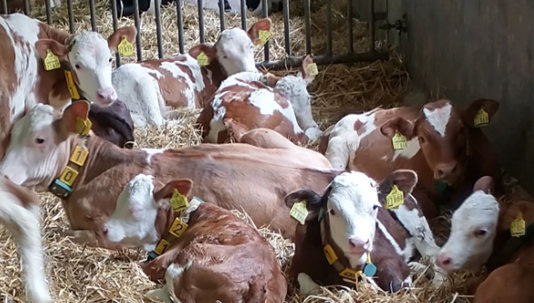It is not only the conditions in one's own barn that determine the success or failure of fattening, the course for healthy and happy animals is largely set before they are housed on the fattening farm. Various studies confirm that the longer calves are in the marketing chain, the greater the chance that the animals will suffer from a respiratory disease during fattening. Therefore, it is advisable to purchase calves with as few middlemen as possible. But it is not only the number of hands through which the animals pass before they reach the fattening farm that influences the incidence of disease. The number of origins from which the calf group is made up also plays a role. The optimal case is a direct purchase of animals from one or a few permanent farms.
 A calf group with calves from only one origin, but of different sizes. This system can sometimes be better for animal health than animals of the same age from many farms. (Photo: von Deylen)
A calf group with calves from only one origin, but of different sizes. This system can sometimes be better for animal health than animals of the same age from many farms. (Photo: von Deylen)A healthy calf is lively and alert with a short and shiny coat; eyes and nose are free of crusting or discharge. The respiration rate of a healthy calf (as seen by the movement of the flanks) is 30 to 40 breaths per minute. If a calf does not meet these criteria when it is brought in, it should be housed separately. This simplifies the observation and treatment of the animal and reduces the risk of spreading the disease. It is crucial for the development of a resilient immune system that all calves are supplied with sufficient colostrum at an early stage. The recommendation here is 3 litres in the first four hours. The quality of the colostrum is also important. Especially in heifers, the quality of the colostrum is often lower than in older cows. In the further course, ad libitum feeding of the calves as well as early acclimatisation to solid feed has proven to be advantageous. Supplementation with vitamins and minerals also contributes significantly to healthy animals. Vitamin E, selenium and iron are particularly worth mentioning here.
It is precisely the above-mentioned points that were defined in the Swiss project "ImproCalf" as necessary rearing conditions for particularly healthy calves. The aim of the project was to improve the health status in fattening through improvements on the farm of origin. That is, to reduce mortality in fattening as well as the use of antibiotics. Based on research and the results of a survey among farmers, veterinarians and other stakeholders, specific rearing conditions were defined. The rearing strategy for the experimental animals consisted of: Ad-libitum feeding, vitamin E, selenium and iron supplementation, vaccination against parainfluenza-3 virus and bovine respiratory syncytial virus, and the use of calf jackets at low temperatures. The comparison bulls, on the other hand, were fed restrictively and received neither additional vaccinations nor supplementary feed.
A total of 5 fattening runs on two fattening farms were evaluated. The ImproCalf calves and the comparison animals (from the same farms of origin) were compared in terms of performance, morbidity, mortality and use of medication. The desired result, namely healthier fattening animals and thus lower losses and less medication use, could not be achieved. However, the ImproCalf animals were already significantly heavier at housing, the higher haemoglobin content detectable up to the 12th week after housing helped them to achieve a more robust condition and they reached slaughter weight 10 days earlier.
For further reading on calf health https://secure.caes.uga.edu/extension/publications/files/pdf/B%201500_1.PDF
Impact:
- Socio-economic resilience: Accurately recording so much data for one calf can be time consuming and therefore costly
- Animal health and welfare: Calfes that grew up healthy are healthier later on
- Production efficiency and meat quality: Accurately recording so much data for one calf can be time consuming and therefore costly
Source:
- Rell, J.; Wunsch, N.; Home, R.; Kaske, M.; Walkenhorst, M.; Vaarst, M. (2020) Stakeholders’ perceptions of the challenges to improving calf health and reducing antimicrobial use in Swiss veal production. Prev. Vet. Med. Preventive Veterinary Medicine Volume 179, June 2020, Article 104970
- Rell, J. et al. (2020): ImproCalf – Improvement of veal calf health through adjustment of rearing conditions on dairy farms. Abschlussbericht
- Mahlkow-Nerge, K. (2011): Was bei Rindergrippe hilft. In: Thema: Was Kälber wirklich brauchen. Retrieved 19.04.2022 from AgrarHeute.com https://docplayer.org/27239349-Thema-was-kaelber-wirklich-brauchen.html